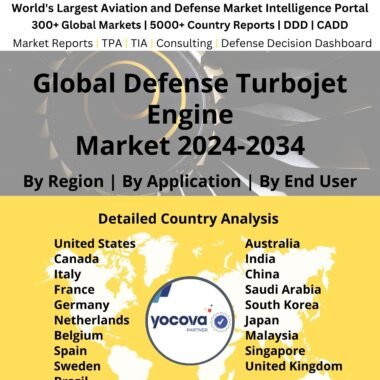Description
Aluminum In Component Aerospace and Defense Market
The global market for aluminum components in the aerospace and defense industry has witnessed significant growth and transformation over the years. Aluminum, known for its lightweight and versatile properties, has become a critical material in the manufacturing of various aerospace and defense components. Its history in the aerospace sector dates back to the early 20th century when aluminum alloys were first incorporated into aircraft design. Since then, continuous advancements in metallurgy and fabrication techniques have improved aluminum’s performance, making it an indispensable material in the aerospace and defense sector.
Another crucial advantage of aluminum components is their corrosion resistance. Aerospace and defense applications often expose components to challenging environmental conditions, including high humidity, temperature fluctuations, and exposure to various chemicals. Aluminum’s natural oxide layer provides inherent corrosion resistance, ensuring the longevity and reliability of critical components under these harsh conditions. This property is particularly important for maintaining the structural integrity of aircraft and spacecraft throughout their operational lifetimes. Cost-effectiveness is another significant factor contributing to the widespread use of aluminum components. Compared to other materials commonly used in aerospace and defense, such as titanium or composites, aluminum is more readily available and generally less expensive to produce. The lower production costs of aluminum translate into cost savings for manufacturers, allowing them to offer competitive pricing for their products.
The ease of fabrication is a key advantage of aluminum that appeals to aerospace and defense manufacturers. Aluminum alloys can be easily formed into various shapes, allowing to produce complex components required in modern aircraft and spacecraft designs. This flexibility in fabrication enables manufacturers to meet stringent design specifications and performance requirements while maintaining cost efficiency. Sustainability and environmental considerations have become increasingly important in the aerospace and defense industry. Aluminum’s recyclability is a compelling factor in this context. The recycling process for aluminum requires significantly less energy compared to primary production, making it an environmentally responsible choice. As sustainability practices gain prominence, the aerospace and defense industry is likely to emphasize the use of recycled aluminum to reduce its environmental impact.
The Global market for aluminium components in the aerospace and defense industry can be segmented based on their applications. In the context of aircraft components, aluminum is extensively used in the construction of fuselages, wings, and landing gears. Fuselage panels and extrusions made from aluminum alloys provide the necessary structural strength while keeping weight at a minimum. Aluminum’s excellent strength-to-weight ratio is also critical for wings, ensuring aerodynamic efficiency and stability during flight. Additionally, landing gears benefit from aluminum’s ability to handle heavy loads without adding excessive weight to the aircraft.
One of the most prominent aluminum alloys used in aerospace is Aluminum Alloy 2024. This alloy was introduced in the 1930s and has since become a workhorse in the industry. It is known for its high strength and fatigue resistance, making it suitable for aircraft structures that endure significant stress during flight. Components like wings, fuselages, and structural elements often utilize 2024 aluminum alloy due to its ability to withstand the rigorous demands of aerospace applications. Another widely used alloy is Aluminum Alloy 7075, renowned for its exceptional strength and toughness. This alloy is favored for high-stress aerospace applications, particularly in critical components like aircraft wing spars, bulkheads, and landing gear parts. The use of 7075 ensures the necessary strength while keeping weight at a minimum, contributing to fuel efficiency and overall aircraft performance. Aluminum Alloy 6063, renowned for its extrudability and formability, is commonly used in aerospace applications for producing various extruded components. These include profiles, frames, and panels used in aircraft and spacecraft construction, where precise shaping and customization are essential. Aluminum Alloy 2014 is valued for its excellent machinability, making it an ideal choice for aerospace applications requiring precise machining. Components such as structural elements and fittings often use 2014 alloy, taking advantage of its machinability without compromising on strength or other mechanical properties. Aluminum Alloy 2124 is a variation of Alloy 2024 with added copper to improve fracture toughness. It is particularly valuable in aerospace applications where resistance to crack propagation is essential. This alloy is used in critical components where the prevention of crack growth is critical for the overall structural integrity of the aircraft. Among the newer developments in aluminum alloys is Aluminum Alloy 2025. Designed to offer improved mechanical properties and increased damage tolerance, Alloy 2025 is being explored for use in future aerospace applications. Its enhanced characteristics aim to meet the evolving demands of modern aerospace technology, providing designers with more options for optimizing component performance.
Global Market for Aluminum Components in Defense
The defense industry is another significant contributor to global aluminum demand, where its applications range from military aircraft to naval vessels and ground-based equipment. Military aircraft, including fighter jets, transport planes, and unmanned aerial vehicles (UAVs), heavily rely on aluminum’s high strength and structural integrity. The lightweight properties of aluminum allow military aircraft to carry more payload and fuel, enhancing their operational range and mission capabilities. Aluminum’s role in the manufacturing of missiles, munitions, and other defense systems is also paramount, providing energy absorption and stability critical for their effective deployment. In naval applications, aluminum plays a crucial role in constructing warships, naval vessels, and submarines. Its corrosion resistance is particularly advantageous in maritime environments, where vessels are exposed to harsh saltwater conditions. Additionally, aluminum’s lightweight properties contribute to the overall buoyancy of naval vessels, allowing for increased payload capacity and fuel efficiency.
Ground vehicles and armor systems within the defense sector extensively employ aluminum due to its high strength-to-weight ratio. In the manufacturing of armored vehicles and personal protective gear, aluminum provides enhanced protection to soldiers and equipment, making it a key material for modern defense systems. Aluminum is frequently employed in the construction of various structural components in missiles, including the airframe, fuselage, and payload compartments. It offers a favorable balance between strength and weight, making it an ideal material for lightweight and maneuverable missile designs. Aluminum is commonly used in missile propulsion systems, particularly in solid rocket motors. Solid rocket propellants often contain aluminum powder as a fuel component, as it provides a high energy output upon combustion. The combustion of aluminum-based propellants generates a significant amount of heat and gas, resulting in thrust and propulsion of the missile. Aluminum’s high thermal conductivity and ability to dissipate heat efficiently make it suitable for use in heat shields and radiators in missiles. These components help protect sensitive electronic systems from the extreme heat generated during missile flight and re-entry.
Process for manufacturing Aluminum Components in Defense and Aerospace
Extrusion is a widely used process that shapes aluminum alloys into various profiles, such as tubes, rods, and structural members. The method involves heating a billet of aluminum and forcing it through a shaped die to produce complex cross-sectional shapes. These extruded aluminum components find applications in aerospace structures and frames. Another crucial technique is sheet metal forming, where aluminum sheets are shaped into parts and components through processes like bending, deep drawing, and hydroforming. These formed aluminum sheets are widely used in the construction of aircraft panels, wings, and fuselage components.
Casting processes, such as sand casting, investment casting, and die casting, are employed to produce intricate and complex shapes for various aerospace components. Cast aluminum parts are utilized in engine components, housings, and structural elements. Forging is also significant, as it results in high-strength aluminum components with structural integrity. Forged aluminum is commonly used in critical aerospace components like landing gears, engine parts, and structural members. The process involves shaping aluminum under high pressure and heat to improve its mechanical properties
Trends Influencing The Aluminum-In Aerospace And Defense Report Market Size
Several future trends are expected to shape the market for aluminum components in the aerospace and defense industry. Lightweighting and efficiency will remain a top priority for manufacturers as they strive to reduce fuel consumption and emissions. Advancements in high-performance aluminum alloys will further enhance the capabilities of aerospace and defense components, allowing for increased strength and durability. Additive manufacturing, also known as 3D printing, is likely to gain prominence as a means to produce complex aluminum components with reduced material wastage. The adoption of sustainable practices will lead to an increased focus on recycled aluminum usage in aerospace and defense applications, aligning with circular economy principles.
Defense Aluminum-In Aerospace and Defense Report Market Forecast & Dynamics
The market for aluminum components in the aerospace and defense industry spans across different regions. North America, with its strong aerospace and defense presence, accounts for a significant portion of the market. The United States, in particular, has a dominant aerospace and defense sector, driving substantial demand for aluminum components. Europe, led by companies like Airbus, is another crucial region in the market. Asia-Pacific has been emerging as a significant player due to the increasing demand for air travel and rising defense spending in countries such as China and India. The Middle East is also witnessing growth, driven by expanding commercial aviation and defense investments.
Furthermore, emerging markets, such as Southeast Asia and Latin America, are expected to play a more significant role in driving the demand for aluminum components as their aerospace and defense sectors continue to expand. Overall, aluminum’s unique properties, coupled with ongoing technological advancements, will continue to make it a vital material in the aerospace and defense industry, ensuring safety, efficiency, and cost-effectiveness in this critical and dynamic sector.
The Market is integral to the continual evolution of aerospace and defense systems. Aluminum’s lightweight yet robust properties make it a cornerstone material for manufacturing critical components across a spectrum of applications. From structural elements in aircraft frames to the production of precision components in defense equipment, aluminum plays a vital role in enhancing performance and fuel efficiency while ensuring durability and resilience in challenging operational environments.
The market is experiencing a surge in demand as aerospace and defense industries worldwide embark on initiatives to modernize fleets and enhance operational capabilities. The emphasis on fuel efficiency and the drive towards lightweight structures to improve aircraft performance underscore the significance of aluminum components. Moreover, aluminum’s corrosion resistance and malleability contribute to its suitability for aerospace and defense applications, where reliability and longevity are paramount. Collaborations and partnerships between aluminum suppliers, manufacturers, and defense contractors are fostering innovation in the production of advanced aluminum components. As the aerospace and defense sector embraces technological advancements, the Global Aluminum Components Market in 2023 reflects a commitment to efficiency, sustainability, and resilience in the face of evolving global security challenges. In essence, aluminum components continue to be instrumental in shaping the future of aerospace and defense systems worldwide.





